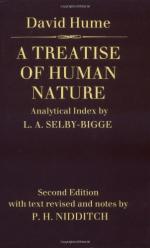The idea of a plain surface is as little susceptible of a precise standard as that of a right line; nor have we any other means of distinguishing such a surface, than its general appearance. It is in vain, that mathematicians represent a plain surface as produced by the flowing of a right line. It will immediately be objected, that our idea of a surface is as independent of this method of forming a surface, as our idea of an ellipse is of that of a cone; that the idea of a right line is no more precise than that of a plain surface; that a right line may flow irregularly, and by that means form a figure quite different from a plane; and that therefore we must suppose it to flow along two right lines, parallel to each other, and on the same plane; which is a description, that explains a thing by itself, and returns in a circle.
It appears, then, that the ideas which are most essential to geometry, viz. those of equality and inequality, of a right line and a plain surface, are far from being exact and determinate, according to our common method of conceiving them. Not only we are incapable of telling, if the case be in any degree doubtful, when such particular figures are equal; when such a line is a right one, and such a surface a plain one; but we can form no idea of that proportion, or of these figures, which is firm and invariable. Our appeal is still to the weak and fallible judgment, which we make from the appearance of the objects, and correct by a compass or common measure; and if we join the supposition of any farther correction, it is of such-a-one as is either useless or imaginary. In vain should we have recourse to the common topic, and employ the supposition of a deity, whose omnipotence may enable him to form a perfect geometrical figure, and describe a right line without any curve or inflexion. As the ultimate standard of these figures is derived from nothing but the senses and imagination, it is absurd to talk of any perfection beyond what these faculties can judge of; since the true perfection of any thing consists in its conformity to its standard.
Now since these ideas are so loose and uncertain, I would fain ask any mathematician what infallible assurance he has, not only of the more intricate, and obscure propositions of his science, but of the most vulgar and obvious principles? How can he prove to me, for instance, that two right lines cannot have one common segment? Or that it is impossible to draw more than one right line betwixt any two points? should be tell me, that these opinions are obviously absurd, and repugnant to our clear ideas; I would answer, that I do not deny, where two right lines incline upon each other with a sensible angle, but it is absurd to imagine them to have a common segment. But supposing these two lines to approach at the rate of an inch in twenty leagues, I perceive no absurdity in asserting, that upon their contact they become one. For, I beseech you, by what rule or standard




